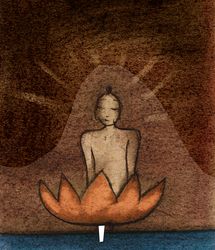India, from time immemorial, has been sharing the values of Buddhism with the world. Buddhism is one common heritage between India and many other nations.
At the recently concluded Global Buddhist Summit, and at the seminar and art exhibition at the National Gallery of Modern Art, Delhi, it was reiterated that the Buddha’s teachings share commonality with the Hindu thought and way of life. We are part of one civilisation, so is Buddhism.
Under Prime Minister Narendra Modi, Buddhism has been playing a significant role in cultivating deeper engagement with the Association of Southeast Asian Nations (ASEAN), as part of India’s ‘Look East’ policy.
One of the most noticeable contributions of Buddhism to the Indian culture is in the realm of architecture—the stupas, the sculptures, the paintings, the viharas, and the chaityas that were built at Sanchi, Amravati, Taxila, Bodhgaya, Nalanda, Bahrut and many other places.
King Siddhartha was an Indian prince who chose the path of enlightenment instead of the luxuries of the royalty.
The Buddha’s meditative practice helped him realise that our problems lie within. We view things through the lens of our beliefs, opinions and prejudices—tools responsible for our partial view of the world inside and outside of us, and, thus, for our eventual suffering. Hence, the Buddha turned his attention towards one single object—his mind.
Buddhism, essentially, is an extension or a branch of an already established Indian school of thought that God is within us. And that we must calm ourselves and control our senses and mind for a peaceful life. Life, ageing and death are realities of life. Gita says that the body is mortal, and the soul, immortal.
The Buddha is said to be the ninth avatar of Lord Vishnu. Whenever there is excess of evil, Vishnu takes birth and establishes Dharma. The Buddha also tried to do the same. He believed in Dharma or Dhamma, which is defined as principles of living life, in which there is harmony between humans and nature.
This is the concept that is found in the teachings of the Buddha and in the inscriptions in temples or stupas that were built by Buddhists. The offerings to the Buddha around the world are roasted sattu powder and crispy sweet made of sugar (batasha), which are eaten commonly in eastern part of India.
In Buddhism, the ‘Ashtamangala’, or eight divine symbols, often represent the gifts given by celestial beings to Shakyamuni Buddha on his attainment of enlightenment. They are parasol, two fish, treasure vase, lotus flower, conch shell, endless knot, victory banner and the wheel of Dharma. Lotus, conch shell, fish and wheels are all derived from ancient Sanatana traditions and are considered sacred in all religions of Indic origin. Inexhaustible treasure vase is characterised by Kubera in Hinduism. In Hinduism, the conch is an attribute of Vishnu. Even the door-keepers I have often seen in the Buddhist monasteries are similar to gatekeepers found in all Hindu temples.
There are so many similarities between Hinduism and Buddhism, and one can safely say that there is a deep connection between these two religions, considering they originated in the same country.
Lekhi is Union minister of state for external affairs and culture.


